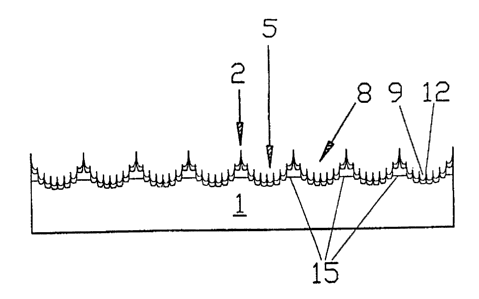Some of the information on this Web page has been provided by external sources. The Government of Canada is not responsible for the accuracy, reliability or currency of the information supplied by external sources. Users wishing to rely upon this information should consult directly with the source of the information. Content provided by external sources is not subject to official languages, privacy and accessibility requirements.
Any discrepancies in the text and image of the Claims and Abstract are due to differing posting times. Text of the Claims and Abstract are posted:
| (12) Patent: | (11) CA 2299446 |
|---|---|
| (54) English Title: | STRIP-SHAPED OR RECIPROCATING KNIFE |
| (54) French Title: | DISPOSITIF COUPANT ALTERNATIF OU SOUS FORME DE BANDE |
| Status: | Deemed expired |
| (51) International Patent Classification (IPC): |
|
|---|---|
| (72) Inventors : |
|
| (73) Owners : |
|
| (71) Applicants : |
|
| (74) Agent: | RIDOUT & MAYBEE LLP |
| (74) Associate agent: | |
| (45) Issued: | 2004-06-29 |
| (86) PCT Filing Date: | 1998-11-05 |
| (87) Open to Public Inspection: | 1999-05-20 |
| Examination requested: | 2000-04-06 |
| Availability of licence: | N/A |
| (25) Language of filing: | English |
| Patent Cooperation Treaty (PCT): | Yes |
|---|---|
| (86) PCT Filing Number: | PCT/DE1998/003223 |
| (87) International Publication Number: | WO1999/024228 |
| (85) National Entry: | 2000-02-02 |
| (30) Application Priority Data: | ||||||
|---|---|---|---|---|---|---|
|
A strip-shaped or
reciprocating knife has at least one elongated
cutting blade (1) provided with a
plurality of cutting teeth (2) and
intermediate cutting gaps (5), the
cutting teeth {2) being provided with
additional, finer teeth (8). In
order to achieve from beginning to
end a smooth and clean cut of the
goods to be cut, the additional teeth
(8) are produced by providing
opposite tooth spaces (9) on both sides
of the knife arranged so close to
one another that sharp teeth (12) are
formed between the spaces. The
additional teeth provided on both
sides of the knife form a sharp
cutting edge which is symmetrically
arranged on both sides of the knife
and extends over the cutting teeth
(2).
Dispositif coupant alternatif ou sous forme de bande présentant au moins une lame coupante allongée (1) pourvue d'une pluralité de dents coupantes (2) et d'espaces coupants intermédiaires (5), ces dents coupantes (2) comportant une denture supplémentaire (8) plus fine. Dans le but d'exécuter une coupe et un sectionnement nets et sans bavures de l'article à couper et de simplifier la fabrication de ce dispositif, on produit la denture supplémentaire (8) au moyen d'entredents (9) situés des deux côtés du dispositif les uns en face des autres et placés à proximité si étroite les uns des autres qu'ils créent entre eux des dents pointues (12), de sorte que la denture supplémentaire des deux côtés du dispositif constitue un bord coupant aiguisé s'étendant au-dessus des dents coupantes (2) et symétriquement des deux côtés du dispositif coupant.
Note: Claims are shown in the official language in which they were submitted.
Note: Descriptions are shown in the official language in which they were submitted.

For a clearer understanding of the status of the application/patent presented on this page, the site Disclaimer , as well as the definitions for Patent , Administrative Status , Maintenance Fee and Payment History should be consulted.
| Title | Date |
|---|---|
| Forecasted Issue Date | 2004-06-29 |
| (86) PCT Filing Date | 1998-11-05 |
| (87) PCT Publication Date | 1999-05-20 |
| (85) National Entry | 2000-02-02 |
| Examination Requested | 2000-04-06 |
| (45) Issued | 2004-06-29 |
| Deemed Expired | 2009-11-05 |
There is no abandonment history.
| Fee Type | Anniversary Year | Due Date | Amount Paid | Paid Date |
|---|---|---|---|---|
| Application Fee | $150.00 | 2000-02-02 | ||
| Request for Examination | $200.00 | 2000-04-06 | ||
| Maintenance Fee - Application - New Act | 2 | 2000-11-06 | $50.00 | 2000-11-03 |
| Maintenance Fee - Application - New Act | 3 | 2001-11-05 | $50.00 | 2001-10-17 |
| Maintenance Fee - Application - New Act | 4 | 2002-11-05 | $50.00 | 2002-09-11 |
| Maintenance Fee - Application - New Act | 5 | 2003-11-05 | $75.00 | 2003-08-22 |
| Final Fee | $150.00 | 2004-04-16 | ||
| Maintenance Fee - Patent - New Act | 6 | 2004-11-05 | $100.00 | 2004-10-05 |
| Maintenance Fee - Patent - New Act | 7 | 2005-11-07 | $100.00 | 2005-09-21 |
| Maintenance Fee - Patent - New Act | 8 | 2006-11-06 | $100.00 | 2006-10-24 |
| Maintenance Fee - Patent - New Act | 9 | 2007-11-05 | $100.00 | 2007-08-17 |
Note: Records showing the ownership history in alphabetical order.
| Current Owners on Record |
|---|
| BALKE, AXEL |
| Past Owners on Record |
|---|
| None |